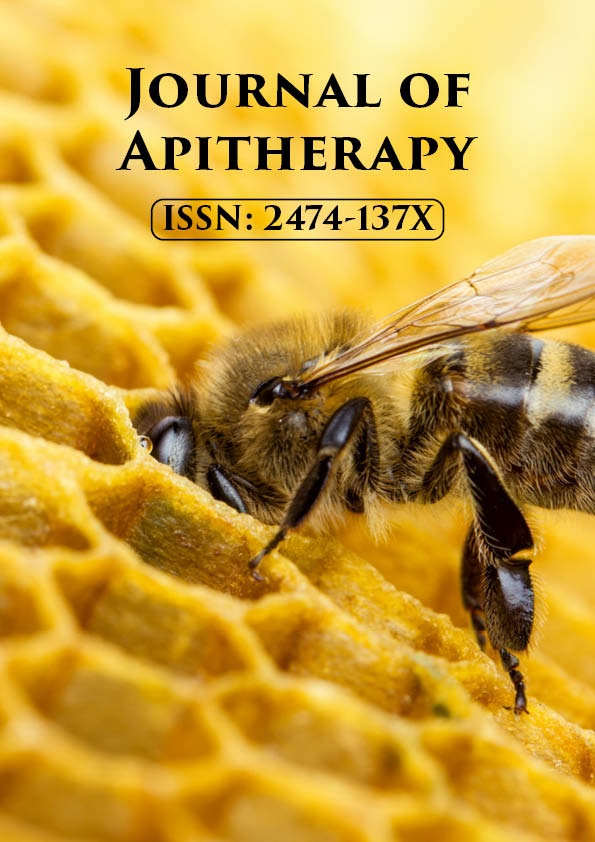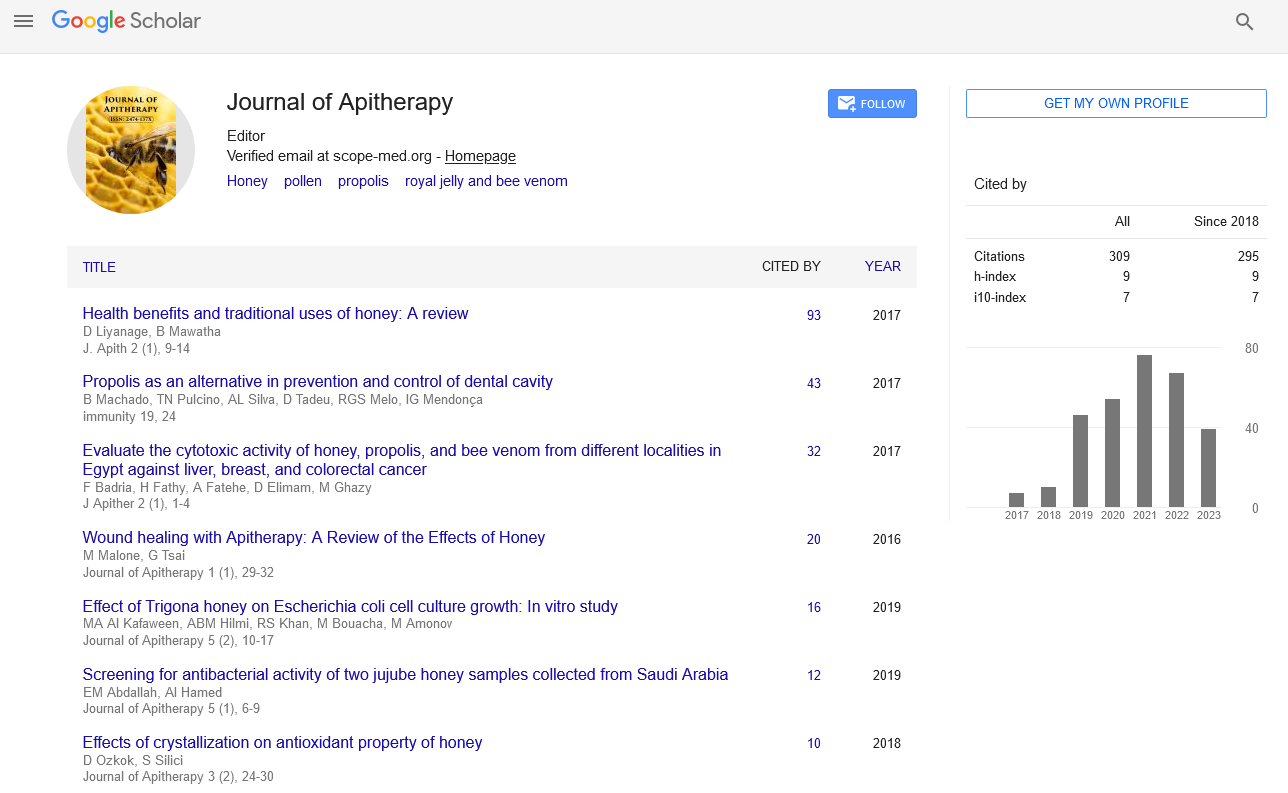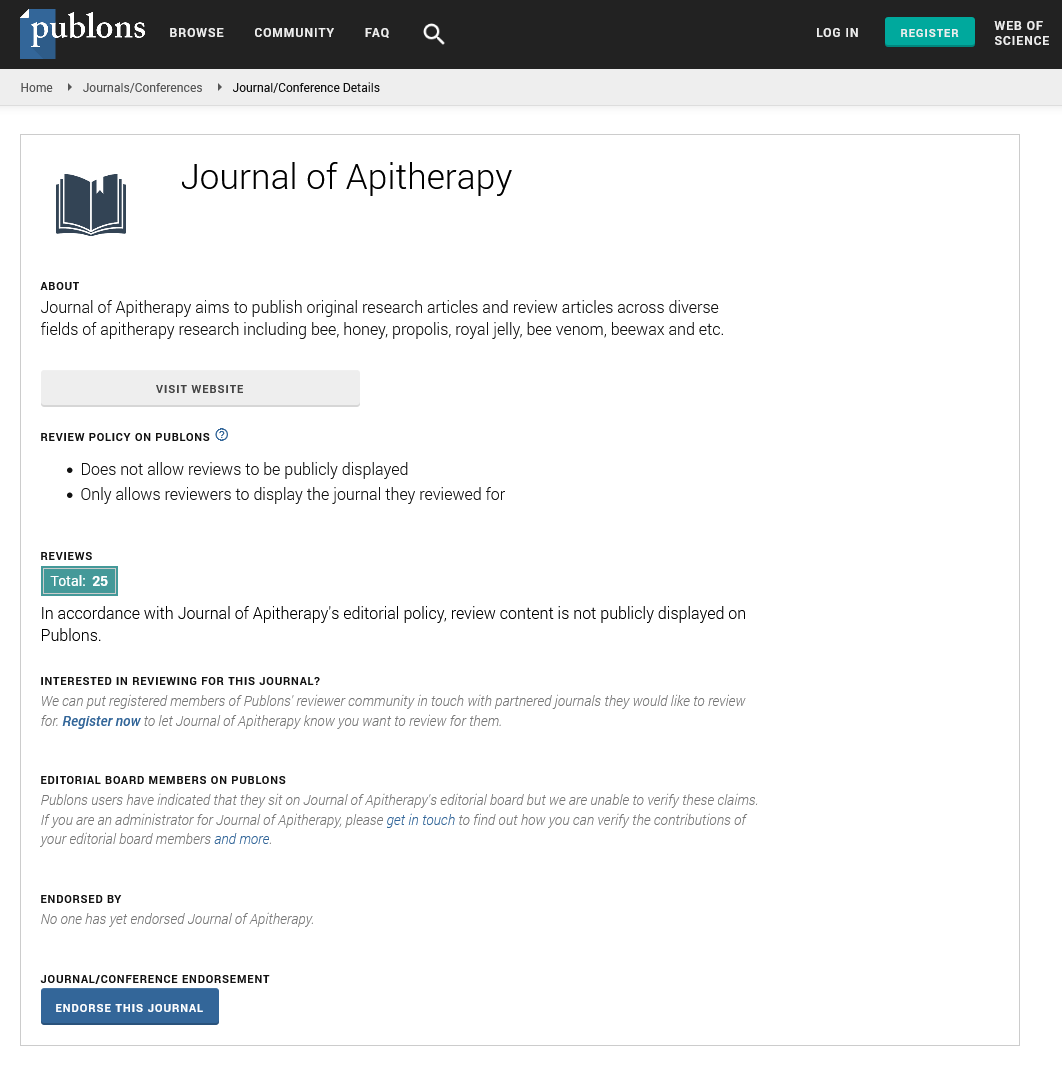Perspective Article - Journal of Apitherapy (2024)
Propolis: Phytocompounds Therapeutic Treasure in Medical Advancements
Liam Carter*Liam Carter, Department of Biomedical Sciences, State University of New York, New York, USA, Email: liam@gmail.com
Received: 26-Apr-2024, Manuscript No. JAPITHERAPY-24-138909; Editor assigned: 29-Apr-2024, Pre QC No. JAPITHERAPY-24-138909 (PQ); Reviewed: 14-May-2024, QC No. JAPITHERAPY-24-138909; Revised: 21-May-2024, Manuscript No. JAPITHERAPY-24-138909 (R); Published: 28-May-2024
Description
Propolis, often referred to as “bee glue,” is a resinous substance collected by honeybees from tree buds, sap flows, and other botanical sources. It plays a critical role in hive construction, defense against pathogens, and the preservation of hive health. Propolis is composed of various phytocompounds-bioactive compounds derived from plants-that contribute to its medicinal properties and therapeutic benefits. This article analyzes the diverse phytocompounds found in propolis, their health-promoting effects, and their applications in traditional and modern medicine.
Composition of propolis phytocompounds
Propolis is a complex mixture of resin, wax, essential oils, pollen, and various bioactive compounds. The composition of propolis can vary depending on the geographic location, plant sources available to the bees, and seasonal factors. However, some of the key phytocompounds commonly found in propolis include:
Flavonoids: Flavonoids are polyphenolic compounds known for their antioxidant, anti-inflammatory, and antimicrobial properties. They help protect the bees and the hive from oxidative stress and pathogens.
Phenolic acids: Phenolic acids, such as caffeic acid and ferulic acid, contribute to propolis’s antioxidant activity and are associated with its anti-inflammatory effects.
Terpenes: Terpenes are aromatic compounds found in essential oils. They contribute to propolis’s antimicrobial properties and give it its characteristic fragrance.
Aromatic aldehydes: These compounds contribute to the antimicrobial and antifungal properties of propolis.
Amino acids, vitamins, and minerals: Propolis also contains essential nutrients that support bee health and contribute to its therapeutic properties.
Health benefits of propolis phytocompounds
The phytocompounds in propolis contribute to a wide range of health benefits, making it a valuable substance in both traditional and modern medicine.
Antimicrobial and antifungal properties: Propolis has long been used to protect the hive from bacterial and fungal infections. Its phytocompounds, particularly flavonoids and aromatic acids, exhibit potent antimicrobial activity against a variety of pathogens, including bacteria like Staphylococcus aureus and fungi like Candida albicans.
Anti-inflammatory effects: Phenolic compounds in propolis, such as caffeic acid and quercetin, possess anti-inflammatory properties. They help reduce inflammation and promote tissue healing, making propolis useful in treating inflammatory conditions like skin irritations and oral mucositis.
Antioxidant activity: Flavonoids and other polyphenols in propolis scavenge free radicals and protect cells from oxidative damage. This antioxidant activity is beneficial for overall health and may contribute to propolis’s anti-aging effects.
Wound healing: Propolis promotes wound healing by stimulating cell proliferation, collagen production, and tissue regeneration. Its antimicrobial properties help prevent infection, while its anti-inflammatory effects reduce swelling and promote faster recovery.
Immunomodulatory effects: Propolis has been shown to modulate the immune system by enhancing immune response and promoting immune balance. This immunomodulatory activity makes it valuable in supporting immune function and overall health.
Future directions and research opportunities
Research into propolis phytocompounds continues to uncover new therapeutic potentials and applications. Future directions include:
Bioactive compounds: Further identification and characterization of novel bioactive compounds in propolis could lead to the development of new drugs and therapies.
Combination therapies: Analyzing synergistic effects between propolis phytocompounds and other natural or synthetic compounds for enhanced therapeutic outcomes.
Biotechnological applications: Developing bioengineered propolis-based products with standardized compositions for consistent efficacy and safety.
Clinical trials: Conducting rigorous clinical trials to evaluate the efficacy and safety of propolis-based treatments for specific health conditions.
Propolis phytocompounds represent nature’s gift for health and healing, offering a rich source of bioactive compounds with diverse therapeutic properties. From its traditional uses in beekeeping and folk medicine to its modern applications in healthcare and skincare, propolis continues to demonstrate its potential in promoting well-being and supporting human health. As research progresses and new discoveries are made, propolis is poised to play an increasingly significant role in medicine, biotechnology, and sustainable agriculture.







